
P-ISSN 1859-3585 E-ISSN 2615-9619 https://jst-haui.vn SCIENCE - TECHNOLOGY
Vol. 60 - No. 11 (Nov 2024) HaUI Journal of Science and Technology 151
NATTO MOISTURE CONTENT HOMOGENEITY IMPROVEMENT
VIA CONTAINING TRAYS TOPOLOGY MODIFICATION
IN HEAT PUMP DRYER
CẢI THIỆN ĐỘ ĐỒNG ĐỀU ĐỘ ẨM HẠT NATTO THÔNG QUA HIỆU CHỈNH CẤU HÌNH KHAY SẤY
TRONG MÁY SẤY BƠM NHIỆT
Nguyen Duc Trung1,*, Nguyen Truong Giang1, Nguyen Duc Nam2,
An Dai Duc1, Nguyen Duc Huy1, Pham Duc Binh1,
Nguyen Huu Khai1, Nguyen Thi Thao3
DOI: http://doi.org/10.57001/huih5804.2024.381
ABSTRACT
Several experiments were conducted in a drying chamber, with Natto as
the test material. These experiments involved varying the number of trays and
the angle of the trays to determine the most appropriate configuration, verify
the uniformity of air distrib
ution in the equipment, and evaluate the
uniformity of the average moisture reduction of Natto seeds in each batch
compared to the established theory in the previous study.
Keywords: Experiment, Natto seed, heat pump dryer.
TÓM TẮT
Một số thực nghiệm đã được tiến hành trong buồng sấy, với Natto làm v
ật
liệu thử nghiệm. Các thực nghiệm này liên quan đến việc thay đổi số lư
ợng
khay và góc của các khay để xác định cấu hình phù h
ợp nhất, xác minh tính
đồng nhất của phân phối không khí trong thiết bị và đánh giá tính đ
ồng nhất
của mức giảm độ ẩm trung bình của hạt Natto trong mỗi mẻ so với mẻ đã thi
ết
lập. lý thuyết trong nghiên cứu trước.
Từ khóa: Thực nghiệm, hạt Natto, máy sấy bơm nhiệt.
1
School of Chemistry and Life Sciences, Hanoi University of Science and
Technology, Vietnam
2Faculty of Electrical Engineering, Hanoi University of Industry, Vietnam
3LIFEFOOD CO., LTD, Vietnam
*Email: trung.nguyenduc@hust.edu.vn
Received: 03/02/2024
Revised: 25/6/2024
Accepted: 28/11/2024
1. INTRODUCTION
The drying process is mainly affected by two factors of
drying air: velocity and temperature. A study conducted
by HAT Norhaida et al. [1] using heat pump equipment to
dry Clinacanthus nutans showed that as air temperature
increases, drying time decreases. The increase in air
velocity also heavily affects the drying time (415, 370, 320,
and 275 minutes at the air velocity of 0.5, 1.0, 1.5, and
2.0m/s, respectively) [2]. The appropriate air velocity for
moisture removal depends on the type of material. For
Bermuda grass, an air velocity of 2m/s results in higher
moisture removal rates compared to velocities of 2.5m/s
and 1.5m/s [3].
Natto, a traditional Japanese food made from
fermented soybeans, has a limited shelf life and needs to
be dried to preserve its nutritional value [4]. The most
suitable drying methods for Natto are heat pump and
vacuum drying. Both have advantages such as high energy
efficiency, better product quality, and no damage caused
by high temperatures [5,6]. Heat pump drying equipment
is used due to the high cost of vacuum drying equipment.
However, non-uniform air distribution in the heat pump
dryer negatively affects the final product quality [7].
Therefore, this study tunes the dryer configuration to
improve air uniformity as well as control the air velocity
and temperature that go through the material.
2. MATERIALS AND METHOD
All experiments at an industrial scale were conducted
at Mangala Biotechnology and Trading Co., Ltd., located
at 264 Ngoc Thuy Street, Ngoc Thuy Ward, Long Bien
District, Hanoi.
2.1. Materials
Fermented soybeans (Natto) are stored at below 4oC
because of thermal sensitivity before heat pump drying

CÔNG NGHỆ https://jst-haui.vn
Tạp chí Khoa học và Công nghệ Trường Đại học Công nghiệp Hà Nội Tập 60 - Số 11 (11/2024)
152
KHOA H
ỌC
P
-
ISSN 1859
-
3585
E
-
ISSN 2615
-
961
9
at 55oC to preserve nutritional values and bioactivity. The
shape of Natto seeds is ellipsoid, whose smallest
dimension is bigger than 8mm. The structure of Natto
seeds is porous. Their average value of moisture content
is 70 (w.b).
Natto seeds at more than 30 (w.b) can be damaged at
ambient conditions in one day because of biological
transfer, so the drying process has to decrease the
moisture content of all Natto seeds to less than 30 (w.b)
in one day. The air distribution in the drying chamber
must be rather uniform to ensure the moisture content
homogeneity of Natto seeds in each tray. The product on
each tray must have an average moisture content of less
than 18 to be ground and pelletized.
2.2. Experiment equipment
The equipment used in the experiment is the same
type and dimension as the one that was simulated in the
study by Nguyen Duc Trung et al. [8]. The Figure 1 shows
the experiment equipment.
Figure 1. Pilot-scale equipment
The notations E, F, C, and H corresponding represent
the evaporator, fan, condenser, and heater. The
equipment capacity is 100kg per batch. The heat pump
system has a compressor capacity of 1.1kW, a condenser
of 4.2kW, and an evaporator of 3.1kW, with a coefficient
of performance (COP) of 3.
Air velocity through the inlet is 10m/s. A thermostat is
used to control the drying air temperature. The
thermostat reads the air temperature and automatically
turns on or off the heater if the air temperature does not
reach 55ºC, with an allowable temperature error of 2ºC
(due to system delay). Several experiments are conducted
to find the configuration for the chamber with the most
uniform product moisture and to ensure that the product
is not damaged.
2.3. Experimental procedure and product
homogeneity evaluation
After conducting three experiments for each
configuration, the presented results show their average.
For the initial configuration of 25 trays, each ith tray is set
on the line which connects from "i"L to "i"R horizontally.
Table 1 and Figure 2 display the position of trays in the
two improved configurations. The tray is set skewed on
the line from iL to (i+1)R or (i+2)R.
Figure 2. Trays place position
Figure 3. Tray dimension

P-ISSN 1859-3585 E-ISSN 2615-9619 https://jst-haui.vn SCIENCE - TECHNOLOGY
Vol. 60 - No. 11 (Nov 2024) HaUI Journal of Science and Technology 153
Table 1. Tray position in each configuration
1st improved configuration 2nd improved configuration
No/Air
shield
Position
No/Air
shield Position
No/Air
shield
Position
No/Air
shield Position
1 3L-4R 8 12L-13R
1 3L-4R 8 12L-14R
2 4L-5R 9 14L-15R
2 4L-5R 9 14L-16R
3 5L-6R 10 16L-17R
3 5L-6R 10 16L-17R
4 6L-7R 11 17L-18R
4 6L-7R 11 17L-18R
5 8L-9R 12 18L-19R
5 8L-10R 12 18L-19R
6 9L-10R 13 19L-20R
6 9L-11R 13 19L-20R
7 11L-12R
Air
shield 1
1L-3R 7 11L-13R
Air
shield 1
1L-3R
Air
shield 2
21L-21R
Air
shield 2
21L-21R
a) 25 - tray configuration b) 13 - tray configuration
Figure 4. Tray place difference configuration
Each experiment uses 35.5 kilograms of material and
55ºC drying air temperature, and the number of trays and
tray angles are tuned. The trays are weighed and
numbered, and each tray has approximately material
weight. The drying process stops when the average
moisture content on each tray is lower than 17% or all the
material causes damage in the drying process. When the
material in one tray has not reached 30% moisture
content in one day, this tray is loaded out, and the empty
tray is placed back in the equipment to ensure air
uniformity.
Each tray's weight changes are tracked every 24 hours
throughout the drying process. To calculate the weight of
Natto seeds on each tray, use the following formula:
mmat = m - mt
(1)
The weight of materials during the drying process is
represented by mmat, while m represents the weight of
the contained material tray, and mt represents the weight
of the empty tray. The formula for calculating the average
moisture content of the Natto seeds (w.b) on each tray
during the drying process:
mat drym
mat
m m
u% m
(2)
where u% is the average moisture content of the
material (AMCOM) on each tray in the drying process (g);
mmat is the weight of the material in the drying process
(g); mdrym is the dry matter weight (g).
The following criteria to evaluate the product
moisture homogeneity:
i
a
u%
u% N
(3)
2
i a
u
(u% u% )
SN
(4)
u
%
a
S
Su%
(5)
The lower the Su and S, the higher the uniformity of
the product moisture after the drying process. The
decreasing in value u%a means that the AMCOM on each
tray tends to decrease.
3. RESULT AND DISCUSSION
The Tables 2, 3 and 4 show the weight and AMCOM on
each tray of the 25, 18, and 13-tray configurations every
24 hours during the experiment. The damaged material is
removed, and the empty tray is put back to ensure proper
air distribution.
Table 2. The AMCOM on each tray in 25 trays configuration (Case 1)
Hrs
No
0 (hr) 24 (hrs) 48 (hrs) 72 (hrs)
m(g) u% m(g) u% m(g) u% m(g) u%
1 1420 70% 743 43% 603 29% 523 19%
2 1422 70% 626 32% 518 18% 498 14%
3 1421 70% 644 34% 524 19% 505 16%
4 1421 70% 849 50% 689 x 566 x
5 1420 70% 932 54% 747 x 624 x
6 1421 70% 985 57% 782 x 648 x
7 1420 70% 1037 59% 809 x 664 x
8 1420 70% 1052 60% 827 x 686 x
9 1420 70% 1056 60% 846 x 706 x
10 1421 70% 1060 60% 850 x 713 x
11 1420 70% 1060 60% 852 x 717 x
12 1420 70% 1062 60% 855 x 722 x
13 1420 70% 1065 60% 865 x 732 x
14 1422 70% 1067 60% 869 x 736 x
15 1420 70% 1062 60% 868 x 738 x
16 1419 70% 1059 60% 865 x 730 x
17 1420 70% 1052 60% 859 x 720 x
18 1420 70% 995 57% 811 x 684 x
19 1420 70% 975 56% 786 x 663 x

CÔNG NGHỆ https://jst-haui.vn
Tạp chí Khoa học và Công nghệ Trường Đại học Công nghiệp Hà Nội Tập 60 - Số 11 (11/2024)
154
KHOA H
ỌC
P
-
ISSN 1859
-
3585
E
-
ISSN 2615
-
961
9
20 1422 70% 963 56% 770 x 642 x
21 1420 70% 951 55% 726 x 603 x
22 1420 70% 754 44% 605 x 514 x
23 1421 70% 635 33% 534 20% 508 16%
24 1420 70% 625 32% 523 19% 493 14%
25 1422 70% 599 29% 497 14% 480 11%
After 24 hours of 1st configuration experiment, almost
all trays have not reached the desired AMCOM. In the next
24 hours, all of the material is damaged. The case 25 trays
are stopped at 48 hours. Three criterion are not calculated
in this case because just 6 out of 25 trays have material at
the end of the drying process.
Table 3. The AMCOM on each tray in first improved configuration (Case 2)
Hrs
No
0 (hr) 24 (hrs) 48 (hrs) 72 (hrs) 96 (hrs) 120 (hrs)
m
(g) u%
m
(g) u%
m
(g) u%
m
(g) u%
m
(g) u%
m
(g)
u%
1 2731
70%
1130
28%
1078
24%
1031
21%
999
18%
971
16%
2 2732
70%
1115
27%
1062
23%
1013
19%
980
16%
950
14%
3 2732
70%
1106
26%
1052
22%
1003
18%
970
16%
941
13%
4 2731
70%
1129
27%
1075
24%
1027
20%
994
18%
966
15%
5 2731
70%
1143
28%
1091
25%
1044
22%
1000
18%
968
15%
6 2730
70%
1160
29%
1111
26%
1066
23%
1025
20%
986
17%
7 2731
70%
1159
29%
1107
26%
1060
23%
1017
19%
978
16%
8 2731
70%
1144
28%
1092
25%
1045
22%
1019
20%
980
16%
9 2730
70%
1127
27%
1078
24%
1033
21%
1004
18%
992
17%
10 2731
70%
1088
25%
1037
21%
1009
19%
982
17%
964
15%
11 2732
70%
1063
23%
1014
19%
987
17%
965
15%
950
14%
12 2731
70%
1040
21%
996
18%
963
15%
946
13%
935
12%
13 2731
70%
1032
21%
985
17%
962
15%
944
13%
932
12%
The reduction in the number of trays in the middle has
improved the moisture reduction uniformity. In this case,
all of the trays have reached a lower 30% AMCOM in one
day. The angle of the trays is changed to 6 degrees, and
two air shields are added at the top of the first tray and
the bottom of the last tray. All trays will reach the desired
AMCOM within six days in this case.
Table 4. The AMCOM on each tray in second improved configuration
(Case 3)
Hrs
No
0 (hr) 24 (hrs) 48 (hrs) 72 (hrs) 96 (hrs)
120 (hrs)
m
(g) u%
m
(g) u%
m
(g) u%
m
(g) u%
m
(g)
u%
m
(g)
u%
1 2731
70%
1134
25%
1076
21%
1024
17%
998
15%
985
14%
2 2731
70%
1162
27%
1102
23%
1048
19%
1020
17%
1007
16%
3 2730
70%
1170
27%
1109
23%
1054
19%
1026
17%
1013
16%
4 2731
70%
1198
29%
1134
25%
1077
21%
1051
19%
1025
17%
5 2729
70%
1223
29%
1166
26%
1113
22%
1072
19%
1046
17%
6 2731
70%
1230
29%
1172
26%
1119
22%
1078
19%
1051
17%
7 2732
70%
1231
30%
1172
26%
1120
23%
1075
19%
1049
17%
8 2731
70%
1224
29%
1166
26%
1113
22%
1072
19%
1046
17%
9 2731
70%
1214
29%
1157
26%
1105
22%
1064
19%
1038
17%
10 2731
70%
1127
28%
1067
24%
1014
20%
989
18%
966
16%
11 2731
70%
1078
27%
1022
23%
971
19%
946
17%
933
16%
12 2731
70%
1050
27%
996
23%
947
19%
922
17%
910
15%
13 2731
70%
985
26%
934
22%
888
18%
865
16%
854
15%
Table 5. Criteria calculated for three case
Case ua Su S
1 - - -
2 14.8% 1.7% 11.7%
3 16.2% 1.1% 6.5%
The trays in the middle section need to increase the
airflow exposure area by increasing the angle of the trays.
The second improved configuration increases the angle
of the 5th tray to the 10th tray to 12 degrees.
All the above experiments are conducted with
approximately equal material weights on each tray.
However, some trays always have better moisture
reduction because they receive more air than the others,
like those near the outlet and inlet, which can increase the
material weight and therefore reduce the material in the
other trays. The tray's weight is determined based on
experience in previous experiments and the simulation
result of the study by Nguyen Duc Trung et al. [8]. If more
air flows through the trays, the weight of the material in
the trays increases.
Table 6. AMCOM on each tray in the last case
Hrs
No
0 (hr) 24 (hrs) 48 (hrs) 72 (hrs) 96 (hrs)
m(g)
u%
m(g)
u% m(g)
u% m(g)
u% m(g)
u%
1 2776
70%
1170
29%
1033
19%
1003
17%
988 16%
2 2720
70%
1149
29%
1035
20%
1006
17%
991 16%
3 2743
70%
1109
26%
1034
19%
1004
17%
989 16%
4 2716
70%
1122
27%
1079
23%
1012
18%
996 16%
5 2722
70%
1133
28%
1042
20%
1013
18%
998 17%
6 2713
70%
1076
24%
1039
20%
1009
17%
993 16%
7 2723
70%
1115
27%
1037
20%
1006
17%
991 16%

P-ISSN 1859-3585 E-ISSN 2615-9619 https://jst-haui.vn SCIENCE - TECHNOLOGY
Vol. 60 - No. 11 (Nov 2024) HaUI Journal of Science and Technology 155
8 2731
70%
1084
24%
1032
19%
1003
17%
988 16%
9 2702
70%
1086
25%
1035
20%
1005
17%
990 16%
10 2737
70%
1105
26%
1030
19%
1001
17%
986 16%
11 2735
70%
1182
31%
1027
19%
1000
17%
984 15%
12 2740
70%
1091
25%
1036
20%
1009
17%
994 16%
13 2741
70%
1071
23%
1038
20%
1013
18%
998 17%
Table 7. Criteria calculated for last case
Case ua Su S
4 16.0% 0.4% 2.3%
The drying time is minimal in all cases. The value of Su
and S is minimal, which shows the effectiveness of the last
configuration. The trays angle values cannot be increased
any further due to equipment limitations, so cases 3 and
4 approaches the optimal design of all the tested cases.
Case 4 reaches the moisture content reduction
homogeneity, and it can be concluded that the material
weight in trays is direct with the amount of airflow the
trays receive.
4. CONCLUSION
In this study, six experiments are conducted using
different configurations in the chamber and a new
method is used for determining the material weight on
each tray. The results indicate that using a configuration
with a middle trays angle of 12 degrees and the others of
6 degrees (13 trays in total) achieves greater product
moisture homogeneity. It matches the prediction by CFD
simulation in [8], where it has the most air uniformity. On
the other hand, the material weight on the trays that have
more air through the tray surface (shown in [8]) could be
more than the others, which is the method for
determining the material weight on each tray to obtain
drying uniformity.
REFERENCES
[1]. Norhaida HAT., Ang WL., Kismurtono M., Siti MT., “Effect of air
temperature and velocity on the drying characteristics and product quality of
Clinacanthus nutans in heat pump dryer,” IOP Conf Ser Earth Environ Sci, 462/1,
012052, 2020.
[2]. Hu Z., Li Y., El-Mesery HS., Yin D., Qin H., Ge F., “Design of new heat
pump dryer system: A case study in drying characteristics of kelp knots,” Case
Stud Therm Eng, 32, 101912, 2022.
[3]. Kumar MA., Kumaresan G., Sivagaminathan M., Rajakarunakaran S.,
Subramanian RS., “Performance Comparison of Tray, Bed and Integrated
Drying Chamber in Closed Loop Heat Pump Dryer for Bermuda Grass,” E3S Web
Conf, 399, 1-14, 2023.
[4]. Weng TM., Chen MT., “Effect of drying methods on Γ-pga, isoflavone
contents and ace inhibitory activity of natto (a fermented soybean food),” J
Food Process Preserv, 36, 483-488, 2012.
[5]. Chou SK., Chua KJ., “New hybrid drying technologies for heat sensitive
foodstuffs,” Trends Food Sci Technol, 12, 359-369, 2001.
[6]. M.Parikh D., “Vacuum Drying: Basics and Application some guidelines
for the selection and use of various types of vacuum dryers,” Chem Eng, 122,
48-54, 2015.
[7]. Shi M., Zhang Y., Wang Y., Gao M., Li J., Deng Z., Liu R., Li M., “Flow
field analysis and design optimisation of Tibetan medicine double heat pump
drying room,” Comput Electron Agric, 199, 107141, 2022.
[8]. Nguyen Duc Trung, et al., “CFD simulation application to evaluate and
enhance the homogenity of air distribution in heat pump dryer,” Hanoi
University of Industry Journal of Science and Technology, 60(6), 121-125, 2024.
THÔNG TIN TÁC GIẢ
Nguyễn Đức Trung1, Nguyễn Trường Giang1, Nguyễn Đức Nam2,
An Đại Đức1, Nguyễn Đức Huy1, Phạm Đức Bình1,
Nguyễn Hữu Khải1, Nguyễn Thị Thảo3
1Trường Hóa và Khoa học sự sống, Đại học Bách khoa Hà Nội
2Khoa Điện, Trường Đại học Công nghiệp Hà Nội
3Công ty TNHH Thực phẩm Cuộc sống



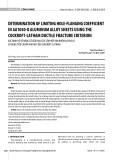

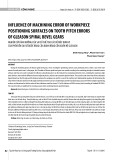

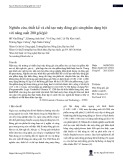
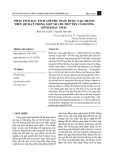
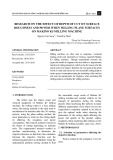

![Đề cương ôn thi Nguyên lý máy [mới nhất]](https://cdn.tailieu.vn/images/document/thumbnail/2026/20260106/cuchoami2510/135x160/90481767694770.jpg)














